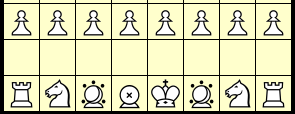Comments/Ratings for a Single Item
 Charles Gilman wrote on Sun, Jul 4, 2004 02:52 AM EDT:Good ★★★★
Charles Gilman wrote on Sun, Jul 4, 2004 02:52 AM EDT:Good ★★★★It looks nice to me, but two more bishops and another knight seems too much. So, I suggest this: R; Cr; N; B; Cb; Co; K; Q; P; Cb; B; N; Cr; R. In this way: Cb= Crowned Bishop, moves like a Bishop or a King (Dragon Horse, Crowned Rook(Cr) = Dragon King); P= Prince, moves like an Archbishop (Bishop + Kinight) (the Concubine (Co) moves like a Chancellor (Rook + Knight)) This looks like a better way to use the board.
Thank´s, but looks like to me that the Duke, by simple analisys, would come to the existence of the Archbishop, the Centaur and the Amazon, just by adding the Knight move to the Bishop, King and Queen, as he did to get the Chancellor (Concubine). Adding the moves of the King to the Bishop and Knight, he would come to the Dragon Horse (Crowned Bishop) and to the Centaur (a Crowned Knight, to keep the line of names of the Duke)(again), as he did to the Rook to get the Dragon King (Crowned Rook). Add King moves to a Queen is useless. So, it´s a mistery to me why he didn't used that pieces.
I thought it possible that the Duke witnessed a game of Shogi at some point and therefore saw a Dragon King and added it as a Concubine to his game. But then, why not also add a Dragon Horse? If the Duke did witness Shogi,and it is purley conjecture, then he still likely would not think of those other pieces (Marshall, Chancellors, Amazons etc.)... if he had thought of them, surely he would have added them? Of course, he might not have wanted to bother with extra piece styles... but then the question remains, why 2 Concubines instead of 2 more Rooks? Even 2 more Queens would have been an improvement. The mystery remains.
Thank´s! To me, a newcomer, feel's very nice to see a recognition of my thoughts. After all, all new comers believe that: 'everything was said before'. And it helps me to think a lot more; and helps in a creative process. I can get it right in the great picture, lots of thoughts. But in the microscope... Anyway. Thank´s a lot! And, coming from a guy with a good name in the site, it menas a lot to me. Thank´s!
I have a question about the rules, I am not sure about the en passant rule. The following rule is described: 'On squares passed over, the pawn can be taken en passant.' Does this mean, if the pawn makes an initial double step en passant is like in orthodox chess? In case of an inital triple step, for example b2-b5, does it mean black pawns a5, c5 could move to b4 taking away b5 OR black pawns a4, c4 move to b3 taking away b5? It could also mean a5,c5,a4,c4 all must move to b4, though I don't think so. Thanks in advance for a clarification.
This is a nice game. It seems to have a theme of rook + weaker piece compounds. I wonder why the board isn't 15x10 to make room for another knight, and have a nice 3:2 shape like Courier Chess. An alternative enhancement would be a pair of camels on d1 and k1 and a camel-rook on i1. That would make more sense of the 10 rank board.
The Duke of Rutland's Chess can be played online against a bot (no registration required) here: https://dagazproject.github.io/checkmate/rutland.htm
Or you can play online against other players on Dagaz Server: https://games.dtco.ru/launch/30/322
In my opinion, this is one of the best chess variants outside the confines of the 8x8 board. It's amazing how a nearly three-hundred-year-old chess variant of the game can be so relevant and stunningly beautiful.
12 comments displayed
Permalink to the exact comments currently displayed.
